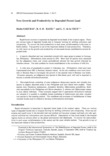Tree Growth and Productivity in Degraded Forest Land
JIRCAS international symposium series
| ISSN | 13406108 |
|---|---|
| NII recode ID (NCID) | AA1100908X |

Full text
intlsymp-1_64-71.pdf299.26 KB
Rapid forest recovery is important in degraded forest lands of the tropical region. There are various types of degraded forests due to frequent burning for shifting cultivation and overgrazing. To recover the land productivity in such areas, re/afforestation is the most reliable method. Tree growth is one of the important indices of land productivity. Therefore,
we will report on the growth and productivity of man-made-forests established in several degraded lands.
1. A heavily disturbed and vast watershed covered with cogon grass is present in Carranglan, Philippines. Afforestation trials started in 1976. More than 20 species were examined for the adaptation trials, and Acacia auriculiformis showed the best growth followed by Gmelina arborea. The main problem for forest establishment is the occurrence of wild fire.
2. A wide area of grasslands is present in Indonesia, too. Afforestation trials have been implemented since 1981 in Benakat, Sumatra island. As the site conditions were more favorable in Benakat than in Carranglan the growth of the planted trees in Benakat was better. Peronema canescens, an indigenous tree species to this island, grew well and is expected to become a suitable silvicultural meterial.
3. Man-made-forests consisting of some indigenous dipterocarp species and valuable tree species in slightly disturbed areas in the Philippines and Java island were studied. These species were Parashorea malaanonan, Anisoptera thurifera, Dipterocarpus grandifloms, Swietenia macrophylla in the Philippines and Shorea stenoptera, S. selanica and Dipterocarpus retusus in Java island, Indonesia. These examples suggest that if appropriate silvicultural methods are adopted it is possible to establish forests consisting of dipterocarps and other valuable tree species by the planting method. The conditions and processes of establishment of these valuable forests must be defined to develop re/afforestation techniques.
we will report on the growth and productivity of man-made-forests established in several degraded lands.
1. A heavily disturbed and vast watershed covered with cogon grass is present in Carranglan, Philippines. Afforestation trials started in 1976. More than 20 species were examined for the adaptation trials, and Acacia auriculiformis showed the best growth followed by Gmelina arborea. The main problem for forest establishment is the occurrence of wild fire.
2. A wide area of grasslands is present in Indonesia, too. Afforestation trials have been implemented since 1981 in Benakat, Sumatra island. As the site conditions were more favorable in Benakat than in Carranglan the growth of the planted trees in Benakat was better. Peronema canescens, an indigenous tree species to this island, grew well and is expected to become a suitable silvicultural meterial.
3. Man-made-forests consisting of some indigenous dipterocarp species and valuable tree species in slightly disturbed areas in the Philippines and Java island were studied. These species were Parashorea malaanonan, Anisoptera thurifera, Dipterocarpus grandifloms, Swietenia macrophylla in the Philippines and Shorea stenoptera, S. selanica and Dipterocarpus retusus in Java island, Indonesia. These examples suggest that if appropriate silvicultural methods are adopted it is possible to establish forests consisting of dipterocarps and other valuable tree species by the planting method. The conditions and processes of establishment of these valuable forests must be defined to develop re/afforestation techniques.
| Creator | Shobu SAKURAI R. S. B. RAGIL L. U. de Ia CRUZ |
|---|---|
| Publisher | Japan International Research Center for Agricultural Sciences |
| Available Online | |
| Issue | 1 |
| spage | 64 |
| epage | 71 |
| Language | eng |
